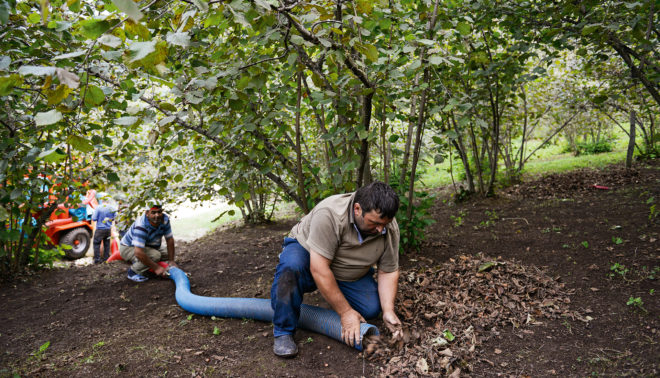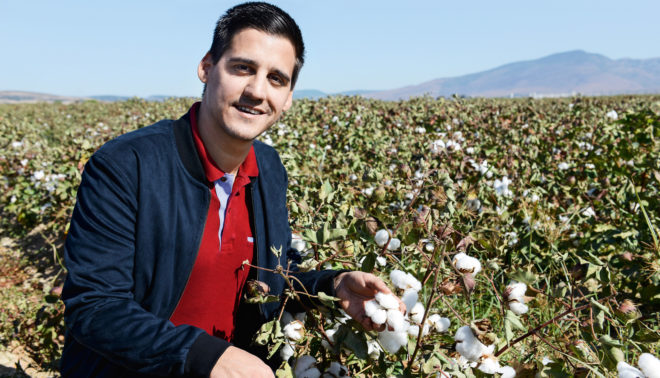Blue shimmering light settles in the early evening over the mountains of the Cumayeri region in the Düzce province. Hazelnuts are thriving wherever you look. After several days of rain, farmers have put back the hazelnut harvest again. Another two dry weeks and the harvest will be over in this region by the end of September. To the right and left, you can see workers on the slopes, harvesting from the multi-stemmed, dense and high-growing bushes. Lots of hands are on deck, gathering together the hazelnuts which have fallen onto the humus-rich ground in order to transport them to the harvester with a suction device. The Findik Maccina, which means something similar to hazelnut machine, separates the nuts pneumatically by agitating them away from their brown-leaved shells. Small leaf fragments are flung high into the air whilst the hazelnuts are tossed into the jute sacks. The air smells nutty and earthy.
105 FARMING FAMILIES AND ONE MOSQUE
A gravel path leads to the Ak family’s farm in Üvezbeli. Shortly before, hazelnuts from a neighbouring farm were laid out on some open ground to dry. The small neighbourhood is around 500m above sea level, houses 105 farming families and has a mosque. Jusuf and his son, Vedat, greet us warmly.
Next to a shed, in front of which there is a tractor and their own Findik Maccina, which the family also uses for contract work at other farms, freshly-picked beans from the garden have been laid out to dry. Behind their house, the wall of which features a large poster of the Turkish president and the roof has a large satellite dish, there is a small stable, in which a cow, a heifer, two bulls, and a calf are housed.

Hazelnut grower Jusuf Ak on his farm.
But back to the hazelnuts. They are the Ak family’s source of income, which is also the case for many thousand Turkish farmers in the moist summer warmth of the mountainous Black Sea region, which extends for almost 1000km from Düzce to Trabzon. More than 60% of hazelnuts produced across the world are grown here.
Jusuf’s brother, Mehmet Ak, is also active in this sector. As well as his farm, he also runs a hazelnut collection point opposite the mosque. Large jute sacks are stacked in storage. Farmers arrive with tractors and full trailers; private producers bring smaller quantities. Every sack of hazelnuts is sampled. Appearance, flavour and moisture are evaluated here. Mehmet Ak sits happily behind a large desk, drinking tea, and decides on the price.
MANISA IS FAMOUS FOR SULTANAS
Around 600km further to the south-west, in the province of Manisa, hazelnuts are not important at all. Here, several types of fruit varieties like grapes, cherries, peaches, melons, as well as vegetables, spices, grain maize and cotton dominate farming in the wide valleys, which are surrounded by snowy mountain ranges in winter. Temperatures are higher here than in the Black Sea region, there is much lower rainfall and not much succeeds without irrigation. While the cotton harvest starts in October, grain maize is harvested in the surrounding area of Manisa in September. This is the same on Ahmed Havaleoglu’s land. A lorry is waiting at the edge of the field to transport the gold-yellow harvest to the mill. Neighbouring fields are home to vines and there is a small field for growing melons. The melons were sown by farmer Ismail Keskin from Hacihaliller, which is to the south east of the town of Manisa, into the stubble at the start of July.

By the basket load sultanas are transported from the field to processing locations.
In addition to wheat and pumpkins, Keskin is also planting grapes. The light and seedless grapes from the sultana vine are used for the production of sultanas, a special type of raisins for which the Manisa region is famous. The difference between raisins and sultanas lies only in the drying method. In contrast to raisins, sultanas are not dried in the sun for so long. Therefore they have a lighter skin. The lighter, the better. Some producers therefore dip the grapes in a solution made from potash and plant oil, which dissolves the fine waxy layer on the skin and accelerating the drying process.
Primarily female Kurdish workers spread the harvested sultanas out to dry in the already-harvested wheat and pumpkin fields. After five to 10 days, the women collect the fruits together, which have lost around 85% of their moisture and shake them by the basket load into stationary sieving machines, which separate the sweet harvest from the stalks and leaves. Conveyor belts move the purified sultanas onto lorries, where the harvest helpers share them out with shovels.
WITH MACHINES RATHER THAN BY HAND

Modern cotton harvesting machines are available here.
While the production of sultanas, chilli, table grapes, okra (lady’s fingers) and melons is overwhelmingly still cared for by family farms, the cotton sector is controlled by larger enterprises. In the Menemen area, north of Izmir, lots of cotton is grown. The 26 year-old İlker İyiuyarlar runs a John Deere dealership with his father and uncle, as well as growing 300ha of cotton. Picking by hand, which is still widely practised in the cotton region around the town of Sanliurfa, 1300km further to the east, was almost completely mechanised here some years ago. Modern cotton harvesting machines are lined up ready to use on their own land, but also to do contracting work.
The cotton is separated from the seed in their own de-seeding facility. This fetches, continues İyiuyarlar “with piles of 28 to 30mm, good prices on the cotton market in Izmir.” He did not go for organic farming “because the standards are high and starting this way of farming would only be worth it if prices were twice as high.”
Organic cotton farming would only be worth it if prices were twice as high.
İlker İyiuyarlar
The crop rotation is answering more to the economy than to the fertility of the soil. Only after five years of cotton is another crop planted, which is generally wheat. Even if İyiuyarlar chooses to continue his current growing strategy, things will be changing soon in terms of energy supply. The family is planning to build a photovoltaic system, which will be installed onto a 1.5ha sized area of roofing. “With this, we will be able to take care of a large part of our own energy use,” he says, looking forward to the new era.
Ambitious Goals
Business people such as İyiuyarlar ensure that agriculture provides a strong economic support for the Turkish national economy. Nearly 25% of all workers find employment in the agricultural sector, which forms almost 10% of the Gross National Product. However, urbanisation is also significant here: Now, almost three quarters of the population live in towns. Lots of small operations do not have someone to inherit the farm and thus there is a very dynamic trend of structural change towards larger companies.
Hazelnuts: Thriving in warm weather
The fatty hazelnut is a permanent crop cultivated over many years. On some Turkish farms, hazelnut fields can date back 80 to 100 years. However, the productivity of the shrubs decreases after 40 to 50 years, which is why many famers dig up their hazelnut shrubs when they reach this age and plant again. The hazelnut requires well-aired and humus-rich soil and thrives particularly in places which are warm in the summer and moist. Both the weather, as well as the age of the plant, the height above sea level and the variety all influence the productivity of the harvest, which varies from between 400kg up to 3t/ha.









